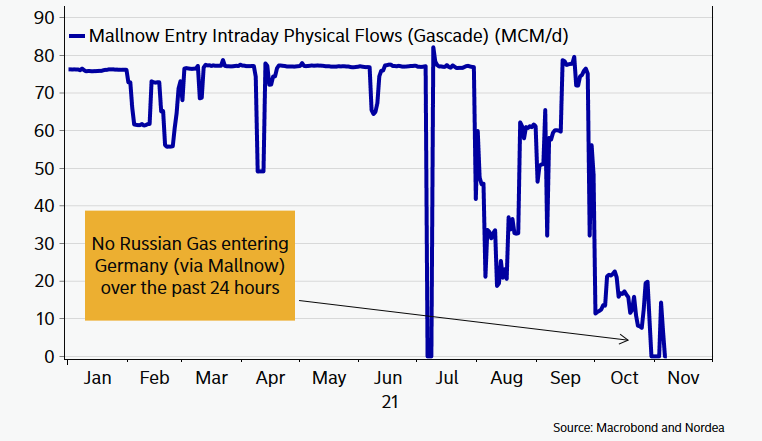Taps Coogan – November 9th, 2021
Enjoy The Sounding Line? Click here to subscribe for free.
Enjoy The Sounding Line? Click here to subscribe for free.
One month ago today, we noted that Gazprom’s natural gas storage sites across Europe were sitting nearly empty and Russian gas flows to Europe were slowing to a trickle at the very time that the EU needed to be building gas inventories for the winter heating season.
One month later, the heating season has started and gas flows through one of the three pipelines that feed Russian gas into the EU have stopped all together, as the following chart from Nordea’s Andreas Steno Larsen highlights.

The Mallnow terminal is the entry point for Russian gas into the EU via Poland. The other two routes are through Ukraine and NordStream 1.
As we explained last time, import capacity isn’t the limiting factor for the EU. However, you can’t import gas that doesn’t exist. Global natural gas production is the real limit and supply tightness is popping up everywhere from Russia, to Asia, to South America.
That problem stems in large part from the West continuing to do everything in its power to discourage natural gas production and associated infrastructure, while eliminating coal (justifiably), and dismantling the nuclear power industry. At the same time, global demand for natural gas as a cleaner alternative to coal continues to grow robustly.
The very people that don’t understand how their past policy choices have contributed to the current energy crisis are the first ones to propose battery storage as a solution to these problems, yet again in defiance of reality.
The grid scale battery applications being built in increasing numbers are almost universally aimed at shifting solar energy output a few hours into the future: from solar noon to roughly 7:00 pm the same day (when electricity demand typically peaks). That’s a useful thing, but unrelated to the current energy crisis.
There is essentially zero battery storage being built to store solar (or wind) energy for the six months required to handle the seasonal trends in renewable production and electricity consumption, not to mention winter heating.
For the foreseeable future all the grid scale battery capacity the world can produce is likely to be consumed smoothing out the intraday variability of wind and solar. In the meantime, the only truly scalable way to bridge the huge seasonal variations in wind and solar and energy consumption while simultaneously reducing carbon emissions is coal-to-gas switching and nuclear.
However, if the US and Europe decided to start building large numbers of nuclear plants tomorrow, few if any would be completed before 2030. That means coal-to-gas switching remains by far the best way for countries like the US, Germany, India, China, etc.. to reduce carbon emissions without causing rolling blackouts, rationing, and ridiculous heating bills.
That of course would require more natural gas production, which would in turn require less vilification and black-listing of the industry and the infrastructure that supports it, so don’t expect it to happen any time soon.
In the meantime, for those that can manage one, a wood stove is likely to be the only respite from brutal heating bills, something which is likely to rile the ‘environmentalists’ to no end.
Would you like to be notified when we publish a new article on The Sounding Line? Click here to subscribe for free.


“The very people that don’t understand how their past policy choices have contributed to the current energy crisis are the first ones to propose battery storage as a solution to these problems, yet again in defiance of reality.”
I like investing based on policymakers’ stupid decisions.
> There is essentially zero battery storage being built to store solar (or wind) energy for the six months required to handle the seasonal trends No where near six months of storage will be needed outside of areas above of latitude of northern germany. Although not ideal, avg kwh/m2/day from below the latitudes above, at worse, gets ~1 kwh/m2/day around January (Chile is about 6 times this much at its worse months during the year), and with enough m2 for CPVCSP systems with 17.5+ hours of storage that exist today should be enough. Europe would need about ~1700 * 6… Read more »
You don’t need six months of storage. You need to store for six months.
That means those batteries cannot also be the ones charging and depleting intraday to smooth out the 0-100% intraday fluctuations in solar and wind.
Hydrogen is extremely energy inefficient.
While the sun is up, the molten salt tanks aren’t really needed for CPVCSP, 17.5 hours of storage is needed for when the sun is down.
CPVCSP is a 24/7 system. Molten salt storage is well tested and used at many plants for years now and storage capacity hours continues to grow for pretty much every new plant that’s +100MW globally. LCOE is already cheaper than nuclear.
CSP with 12 hours of energy storage has a levelized cost of twice normal photovoltaics as of 2020. That’s why so few CSP plants get built. ?itok=LRwishKG Again, the storage you are talking about is intraday. It does nothing for the seasonal fluctuations in solar output which in temperate climates is about five-fold https://www.sunlightinside.com/light-and-health/light-and-the-winter-blues/ That means a solar based system has to be overbuilt five fold to capture enough solar energy over the summer to carry it into the winter. Molten salt batteries don’t storage energy that long so you need lithium ion batteries on top of your intraday batteries… Read more »
Not mentioned in article is desire for Russia to have long term supply contracts for supply of gas so they can better invest in pipelines, storage and and other facilities whereas Europe favors short term spot market pricing at their own peril,